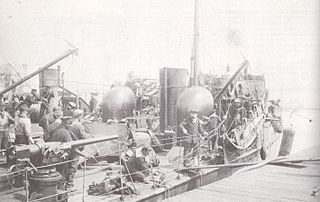
The Beagle class was a class of sixteen destroyers of the Royal Navy, all ordered under the 1908-1909 programme and launched in 1909 and 1910. The Beagles served during World War I, particularly during the Dardanelles Campaign of 1915.

The Paulding-class destroyers were a series of United States Navy destroyers derived from the Smith class with the torpedo tubes increased from three to six via twin mounts. They were the first destroyers in the US Navy with oil-fired boilers. The 21 Pauldings doubled the number of destroyers in the US Navy. The Paulding class derived its name from the class's lead ship, Paulding, named for Rear Admiral Hiram Paulding (1797–1878). Like the Smiths, they were nicknamed "flivvers" after the small and shaky Model T Ford once the larger "thousand tonner" destroyers entered service.

The Caldwell class of destroyers served in the United States Navy near the end of World War I. Four served as convoy escorts in the Atlantic; the other two were completed too late for wartime service. Two were scrapped during the 1930s, but four survived to serve throughout World War II, three of these in service with the Royal Navy under the Destroyers for Bases Agreement.

The River-class destroyer was a class of torpedo boat destroyer built for the Royal Navy at the turn of the 20th century, and which saw extensive service in World War I. The class introduced new features to destroyer design, placing a greater emphasis on seakeeping and endurance and less on a high maximum speed in good weather. All the ships were named after British and Irish rivers, and as such were the first Royal Navy destroyer class to be named systematically.
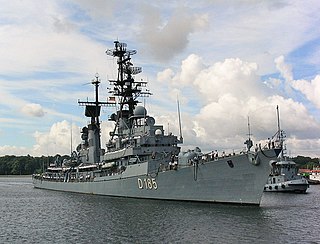
The Type 103 Lütjens class was the last class of destroyers in service with the German Navy. The ships were US Charles F. Adams-class guided missile destroyers but with some modifications to meet German requirements.

The Brazen class formed part of a general class of forty turtleback destroyers capable of 30 knots built around the end of the 19th and the start of the 20th century for the Royal Navy.

The C class as designated in 1913 was a heterogeneous group of torpedo boat destroyers (TBDs) built for the Royal Navy in the late-1890s. They were constructed to the individual designs of their builders to meet Admiralty specifications. The uniting feature of the class was a top speed of 30 knots, a "turtleback" forecastle and that they all had three funnels. The funnels were spaced equidistantly and were of equal height, but the central one was thicker.

The D class as they were known from 1913 was a fairly homogeneous group of torpedo boat destroyers (TBDs) built for the Royal Navy in the mid-1890s. They were all constructed to the individual designs of their builder, John I. Thornycroft & Company of Chiswick, to meet Admiralty specifications. The uniting feature of the class was a top speed of 30 knots (56 km/h) and they all had two funnels. In 1913 the nine surviving "30 knotter" vessels with two funnels were retrospectively classified by the Admiralty as the "D" class to provide some system to the naming of HM destroyers. In the same way those with three funnels were classified as the "C" class and those with four funnels as the "B" class. All these vessels had a distinctive "turtleback" forecastle that was intended to clear water from the bow, but actually tended to dig the bow in to anything of a sea, resulting in a very wet conning position. They were better constructed than their A-class forebears, but still were poor seaboats unable to reach top speed in anything but perfect conditions.

The B class as designated in 1913 was a heterogeneous group of torpedo boat destroyers (TBDs) built for the Royal Navy in the late 1890s. They were constructed to the individual designs of their builders to meet Admiralty specifications, the uniting feature being a specified top speed of 30 knots (56 km/h) and four funnels, although the funnel spacings differed between ships. All "30 knotter" vessels with four funnels were classified by the Admiralty as the B class in 1913 to provide some system to the naming of HM destroyers.

The Acorn class was a class of twenty destroyers of the Royal Navy all built under the 1909-1910 Programme, and completed between 1910 and 1911. The Acorns served during World War I.
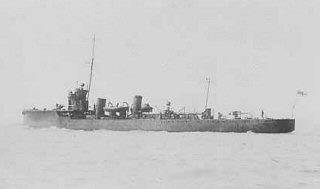
The Acheron class was a class of twenty-three destroyers of the British Royal Navy, all built under the 1910-11 Programme and completed between 1911 and 1912, which served during World War I. A further six ships were built to the same design for the Royal Australian Navy as River-class destroyers. There was considerable variation between the design and construction of ships within this class, which should be considered as more of a post-build grouping than a homogeneous class.
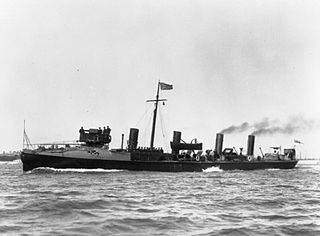
Two Ferret-class destroyers served with the Royal Navy. Ferret and Lynx were built by Laird, displaced 280 tons and were 199 feet (61 m) in length. They were armed with one 12-pounder gun and two bow torpedo tubes. They carried a complement of 53.

The three Ardent-class torpedo boat destroyers were ordered by the British Admiralty on 12 October 1893 and served with the Royal Navy. Built by Thornycroft for a contract price of £110,520 for all three vessels, they displaced 301 tons fully laden, and were 201 feet 8 inches (61.47 m) long overall.

HMS Dove was a three funnel, 30 knot destroyer ordered by the Royal Navy under the 1896–1897 Naval Estimates. She was the ninth ship to carry the name.
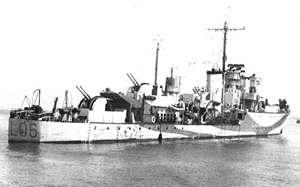
HMS Avon Vale(pennant number L06) was an escort destroyer of the Hunt Type II class. The Royal Navy ordered Avon Vale's construction three months after the outbreak of the Second World War. John Brown Shipbuilding & Engineering Company Ltd laid down her keel at their Clydebank yard on 12 February 1940, as Admiralty Job Number J1569. After a successful Warship Week national savings campaign in February 1942, Avon Vale was adopted by the civil community of Trowbridge, Wiltshire.
HMS Leopard was a Vickers three funnel - 30 knot destroyer ordered by the Royal Navy under the 1895 – 1896 Naval Estimates. She was the ninth ship to carry this name since it was introduced in 1635 for a 34-gun ship, captured by the Dutch in 1653.

The Nembo class was a class of destroyer of the Italian Regia Marina. Six destroyers were built by the Pattison shipyard of Naples between 1899 and 1905, to a design based on the contemporary destroyers of the British shipyard Thornycroft. They were active in the Italo-Turkish War and in the First World War, where three were lost.


